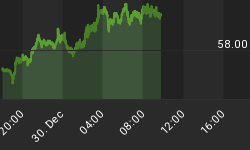The following is part of Quick Pivot that was publishedfor our subscribers February 18, 2011.
Signs of the Times:
"The bases are loaded. You've got all this monetary stimulus." ~ Financial Post, February 4, 2011
"Jump Aboard The Commodity Train" ~ Financial Post, February 4, 2011
"Another Merger Monday" ~ Business News Network, February 7, 2011
"Commodities Drive Surge In Toronto Stock Exchange" ~ Financial Post, February 15, 2011
"Bernanke: Don't Blame Me for Higher Food Prices" ~ Wall Street Journal, February 4, 2011
All we would add to the latter quote is that Bernanke's helicopters are reaping a whirlwind. Furthermore - the Fed wanted price inflation.
A Speculative Eruption
The transition from a market with intermediate ups and downs to runaway speculation is always interesting. As noted in late October, this was possible and was confirmed in November when our Momentum Peak Forecaster started going straight up. This only happens on a big speculative lift off and the signal that anticipates the eventual culmination occurs when the Forecaster stops going up.
That stopped going up at the end of December and on examples back-dated to 1970 the action blew out from one month to three months later. In 2006 the big action was in housing and the signal was given in May and the Case-Schiller Index peaked in June and we wrote the article on real estate booms and busts that August.
The model works on the big speculation and doesn't care what it is in.
In the 1973and 1980 examples, the buying frenzy was mainly focused in commodities and the signal lead the peak on the first by 3 months and on the second by 2.5 months. Obviously, within our All-One-Market theme, the big action is again in commodities. Perhaps conclusions to the two earlier examples can provide some guidance.
This time around, this provides a window of culmination around the latter part of March. Does this guarantee that the action will continue wild for some four to six weeks?
No - and this is bothersome for traders - it seems like dancing on the edge of a cliff. When the music is good it is hard to stop.
Then there is the consideration of magnitude as in "How far is up?"
In this regard, the higher the reading the more frenzied the game. Any signal above 1.21 has been dangerous and the highest at 1.37 was clocked with the 1980 mania in gold and silver. The next highest was 1.36 set with the mania on narrowing credit spreads that took out Long Term Capital Management in 1998.
The high at year's end was 1.28, which compares to the 1.23 reached with the 1974 commodities boom.
This suggests that this buying mania may not be as wild as the precious metal action in 1980, but it could be more than recorded for most commodities in 1974.
On the near term, the gold/silver ratio has been providing some guidance. The rise through the first three weeks of January was a caution, but the subsequent decline to new lows this week says that the party is still on. Typically, the ratio declines during the good times and goes up in the post-party hangover.
COMMODITIES
The main trend is up and it could continue for a number of weeks. However, this is ending action and the hot participants may not all peak at the same time.
Often at important lows or tops base metal mining stocks lead the turns in base metal prices. Mining stocks (SPTMN) have accomplished a high weekly RSI and are looking toppy. A little more weakness will provide a warning on base metal prices. The gains since the crash have been outstanding with the stock index soaring from 178 to 1600 last week. Using Goldman's metal index (GYX), the gain from 187 to 496 amounts to 165 percent. This compares to 800 percent for the SPTMN, which confirms that funds more readily buy stocks than metals.
At the highest RSI since the cyclical high in 2007, the sector will soon be vulnerable to pending credit problems.
Over in the oil patch, the action has not been as big with the stocks (XOI) working on a double from the crash low. However, seasonal forces are favourable into April and this could fit with the "Forecaster" blow-off continuing into the latter part of March. It is worth adding that the weekly RSI is at 82 and that slightly exceeds the excitement of 2007.
Technical tools independent of our Forecaster are recording excesses and this shows in the agricultural sector.
The ETF on Ag stocks is the COW on Toronto and it is working on the same pattern at the cyclical high in 2008. Then the action registered an Upside Exhaustion and agricultural stocks peaked two months later.
This time around, the Upside registered on January 18 and the weakly chart continues strong with virtually no correction since the rally began in July. Using the two-month count, the Upside pattern could conclude later in March.
This week, agricultural prices (GKX) registered a weakly Upside Exhaustion - the first since 2008.
"Analysts have always found it difficult to quantify effervescence" is an old saying, but our historical work has suggested that the window of effervescence could be open into March. Our technical models are an attempt to measure excessive exuberance that has a good track record.
After so many months of watching for market-ending excess it is a relief to find independent confirmations. That is in degree and timing.
Link to February 19, 2011 'Bob and Phil Show' on Howestreet.com: http://www.talkdigitalnetwork.com/2011/02/window-of-effervescence















